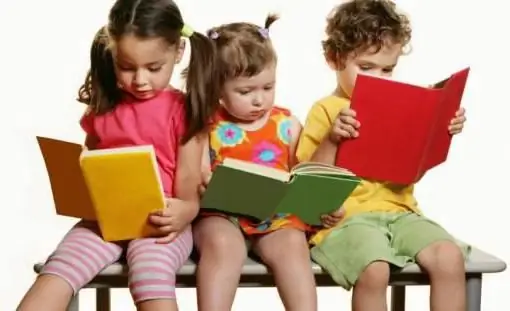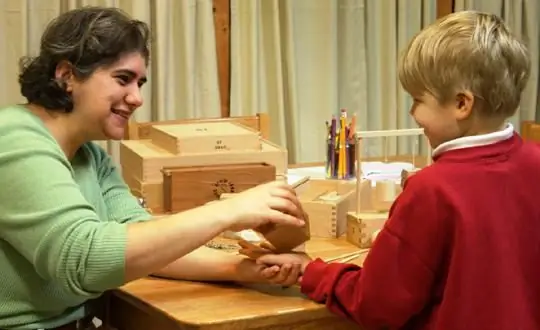2026 Author: Priscilla Miln | [email protected]. Last modified: 2025-01-22 17:55:27
Didactic games in kindergarten are a difficult job for a teacher. This is both a playful way of teaching a child, and a uniform one. During such games, the baby develops comprehensively, learns by playing what will be interesting for him, and therefore productive. In the article we will talk about the types and structure of didactic games with children of younger and older preschool ages. Also in the publication there are interesting ideas for working with preschool children.
The originality of didactic games

A didactic game is an event aimed at teaching a child and consolidating already acquired knowledge in memory. Here, under the guise of a game, learning tasks that are difficult for a child are performed.
During the game, the maximum mental work, the desire for competition, knowledge, logic, attentiveness and ingenuity are required from the child. There are a lot of different jokes in didactic games, so childreneasily perceive such activities, they are interesting.
The first such games were created by folk pedagogy. Each of us remembers "Gardener", "Edible-inedible", "Fanta", "What flies" and so on. These games are didactic.
On the creation of the methodology
The structure of didactic games was created by the German Friedrich Fröbel. It was this person who first called a kindergarten a kindergarten! His exercises were simple, rather boring, but they became the basis for the structure of didactic games with children.
Today there are many interesting activities for the comprehensive development of children. In the formation of the modern structure of the didactic game, we can pay tribute to the following people: Mikheeva E. M. developed a system of games to introduce children to the world around us, as well as activities that help develop speech; Sorokina A. I. created a system for the development of children of preschool age.
The structure of the didactic game

As mentioned earlier, didactic games are a complex pedagogical process. To hold an event, it is not enough to know a couple of games, it should be a system that will help the child develop comprehensively: sensory development, speech, logic, knowledge of the environment, the ability to communicate, work in a team, listen, solve problems and complete them, count, and much more other.
The structure of the didactic game with children includes five components, let's talk about each.
Didactic task
It must be determinedteacher, and carries a learning activity. The content can be gleaned from the methodological literature recommended for working with preschoolers. The task is educational, and can appear in the name itself, for example: "We will dress a doll for a walk."
Game task

This component of the structure of the didactic game is carried out by all means in the game activity by the children themselves. Both tasks, both didactic and gaming, link learning and play. The child must show interest in the process. So, for older groups of preschoolers, there is an exciting game "Revealing the secret of the magic cap." The game task is to find out what is under the cap, and the educational one is to tell as much as possible about the object that is under the cap (you can put a sock, the child must describe it - the color, what it feels like, what it is for, and so on).
Game actions
This is the main component of the structure of the didactic game, without which the process of the game is impossible. It is the action that should be laid here - hiding an object, finding it, guessing riddles, staging role-playing games (daughters-mothers, playing in the hospital, and so on), competitions. What is the learning part? The child needs to be taught to play, for example: "Shop" - the teacher explains the role of the seller and the buyer, the actions of the parties, teaches them to talk. Hide and Seek tells how to hide, how to seek.
Rules

The structure of the didactic game includes the ruleswhich determine the course of the lesson, direct the role of children and their behavior, relationships. Rules are a disciplining, teaching and organizational component. That is, children need to be explained what cannot be done and why, to organize the game itself, to determine its course. The game should not be overloaded with rules, this can provoke a loss of children's interest in the process, as well as cunning tricks that will help break the rules unnoticed.
Result
The last component of the structure of the didactic game, but it is also the essence of the event itself. That is, the result should be the assimilation of the acquired knowledge, and not the child receiving a reward in any way!
There is only one conclusion: the didactic game must be structural, because the absence of at least one of the components in the process leads to a break in the entire chain. That is, all components must be interconnected, only in this way it is possible to achieve not only a gaming, but also a learning result.
Organization of the game

Knowing the structure of the didactic game, you can organize its process. Observing all the points, the teacher will achieve the maximum learning result, and the children will receive a lot of positive knowledge. The relationship of all components of the structure of didactic games for preschoolers can be traced according to the plan for organizing and conducting:
Preparing for the game
- Choosing a game according to the objectives of the learning process.
- Generalization in the game of knowledge, deepening in them.
- Development of sensory abilities.
- Maximum activation of children's speech,attention, memory and other mental processes.
- Compliance with the ratio of educational and gaming requirements of children of a certain age group.
- Determination of the optimal time for classes - in your free time, or in the process of learning.
- Choosing the location of the game - in the group, in the gym, in the assembly hall, on the street.
- Determining the number of players. It is important to involve all children here - in groups, in turn, or a mass game.
- Preparing the necessary materials, items that will be useful in the game.
- Determining the place of the educator in conducting classes.
- Studying the game by a teacher - you can't explain what you don't understand yourself!
When everything is ready, you can proceed to the next step:
Conducting a didactic game according to the structure
- Introducing players to the game itself is content, which requires prepared materials and items.
- The distribution of roles in the game, for example: Masha is a seller, Pasha is a buyer, and so on.
- Explanation of the course of the game, for example: Pasha needs to buy this and that. Masha has to sell (find the right item in the box, in the window, find the price tag on it, and so on).
- Explanation of the rules of the game, for example: respect for each other.
- Demonstration of actions, for example: the teacher shows how to enter the store, say hello, how to ask for a product, how to find it, sell it, and so on.
After the game is over, you need to move on to the last component of the structure of the didactic game:
Result
- First of all, ask the children how much they liked the game, and whether they liked it at all. If there are dissatisfied, ask to explain what exactly caused this feeling.
- Check how well the acquired knowledge is learned.
- Summarize: did you manage to achieve a learning and gaming result.
Features of the games

To fully use the structure of the didactic game in kindergarten, the teacher must follow the following rules:
- Generate interest in participating in the game. For example, ask questions that encourage the game (if the game is in the "Shop", then ask what is in the store: scales, trolley, packages, products, toys; who works in the store - the seller, cashier, and so on).
- Keeping the pace of the game. At first, you need to play slowly, focus on learning the rules and following them, as well as learning and understanding the flow of the game by children. Make sure each player understands the point, absorbs the knowledge gained, and pick up the pace.
- In no case should the teacher leave the game, until the last his task remains: keeping children active, joking, pointing out not the most successful solutions (tell, or show how it will be better and easier). Throughout the game, children will encounter gaps in knowledge, prompt, tell.
Game Ideas

We offer to consider various options for games. The first will teach the child to distinguish between words that at first glance are the same.
To play the game you will need a ball. Explain the rules to the children:
- whose hands the ball hit, he explains the words, then the ball is passed to any other player;
- explain words as accurately as possible;
- do not interrupt each other, do not prompt.
Then the game is played: the teacher throws the ball to any of the children, asks to explain the difference between the words cat, kitten, cat (or others, for example: house, house, house, and so on). The child should more accurately explain the difference, and then pass the ball to another. Only the teacher guesses the words.
In the same way, you can play a similar game, but with an explanation of the meaning of one word. For example: bouquet, buffet, milk, table, shoes. Here the child not only describes the object, but also says what it is for.
Another version of the game is to teach children to form nouns correctly, to pronounce words clearly. For the lesson you will need a ball. Rules:
- name the spoken word affectionately, give an example: cat-cat, sun - sun;
- whoever gets the ball in his hands changes the word;
- pronounce the word as clearly as possible;
- do not interrupt each other, do not prompt.
Next play the game by throwing the ball from player to player. Come up with simple words, for example: mom, blacksmith (children will laugh, it will be a little trick: blacksmith - grasshopper), sister, ball, bag, porridge and so on.
These games belong to those that need to start slowly, gradually adding pace. Children will learn to think quickly, will be confused, laugh,drop the ball and so on. The task of the educator is to maintain interest in the game.
There are many didactic games, from simple ones to more complex ones. Examples of games, rules and methods of conducting can be found in the methodological literature, which is recommended for working with preschoolers. Carefully study this or that game, because not everyone will be able to do it for younger groups, and not everyone will be interesting for preschoolers of graduation groups.
Recommended:
Features of the educational process. The function of the family in the field of education

Giving birth to a child is half the battle, but bringing up is a completely different story. Each parent has their own characteristics of the educational process. However, it is important that they are consistent with the goals and objectives of education and upbringing in preschool and school institutions that your child attends. In this case, the needs of the child's personality will be fully satisfied
Educational task. The goals of the educational process

Educational task is set in every educational institution. Even in kindergarten. After all, education is a complex process in which attention is focused on the transfer of knowledge, ways of thinking, various norms from the older generation to the younger. The process has different meanings. But in the end, each child, as he grows, should receive certain skills, moral values, moral attitudes that will allow him to navigate life in the future
Innovative technologies in preschool educational institutions. Modern educational technologies in preschool educational institutions

Today, teams of teachers working in preschool educational institutions (DOE) direct all their efforts to introduce various innovative technologies into their work. What is the reason for this, we learn from this article
Self-analysis of the lesson of the teacher of the preschool educational institution according to the Federal State Educational Standard and its main stages

Not so long ago, the priority of attending a preschool children's institution was to prepare the child for school. The teacher was tasked with teaching the child to read and write. But now, in the age of information technology, everything has changed. So, a number of changes were made to the Federal State Educational Standard, according to which the future student must leave the walls of the preschool educational institution adapted to the school system, a harmonious and developed personality, ready for all difficulties
Modern educational technologies and methods in preschool educational institutions: a brief description

What are modern educational technologies and methods in preschool educational institutions? What are they needed for? First of all, each technology is aimed at the implementation of educational state standards in preschool education

